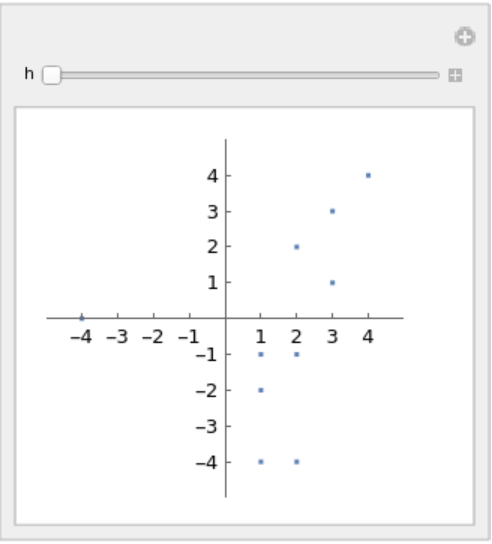Wolfram Function Repository
Instant-use add-on functions for the Wolfram Language
Function Repository Resource:
Sumset gives the sumset of a collection of sets or the h-fold sumset of a set
ResourceFunction["Sumset"][A1,A2,…] gives the sorted set of sums a1+a2+⋯ (with repetitions removed) where ai∈Ai. | |
ResourceFunction["Sumset"][h,A] gives the sorted set of sums a1+a2+⋯+ah (with repetitions removed) where ai∈A. |
Compute the 6-fold sumset of a set of integers:
| In[1]:= |
| Out[1]= |  |
Compute the sumset of points in the plane:
| In[2]:= |
| Out[3]= |
Compute the sumset of points in 3-space:
| In[4]:= | ![setofpoints = {{0, 0, 0}, {0, 1, 1}, {0, 3, -1}, {1, 4, 2}};
set2ofpoints = {{0, -1, -1}, {1, 1, 1}, {2, 2, 2}, {3, 3, 10}};
ResourceFunction["Sumset"][setofpoints, set2ofpoints]](https://www.wolframcloud.com/obj/resourcesystem/images/794/79484f75-5ff6-4abd-a6ab-5111a11fe766/7d76add59129be6c.png) |
| Out[6]= |
The expected size of Complement[Range[2,n],Sumset[2,A]] is just under 10, if A is a random subset of Range[1,n] (reference is Many Sets have More Sums than Differences, G. Martin and K. O'Bryant, Additive combinatorics, 287--305, CRM Proc. Lecture Notes, 43, Amer. Math. Soc., Providence, RI, 2007):
| In[7]:= | ![n = 100;
data = Table[
2 n - 1 - Length[ResourceFunction["Sumset"][2, RandomSample[Range[1, n], n/2]]], {1000}];
Histogram[data, {1}, PlotLabel -> "mean = " <> ToString[Mean[N[data, 2]]]]](https://www.wolframcloud.com/obj/resourcesystem/images/794/79484f75-5ff6-4abd-a6ab-5111a11fe766/2f317dfd4c1a5f1b.png) |
| Out[9]= |  |
As h grows, Sumset[h,A] grows to contain the interior of a polygon (scaled to h):
| In[10]:= | ![domain = Flatten[Table[{i, j}, {i, -4, 4}, {j, -4, 4}], 1];
A = RandomSample[domain, 10];
Manipulate[
ListPlot[ResourceFunction["Sumset"][h, A], AspectRatio -> 1, ImageSize -> Small, PlotRange -> (4 h + 1) {{-1, 1}, {-1, 1}}, Ticks -> {Range[-4 h, 4 h, h], Range[-4 h, 4 h, h]}], {h, 1, 24, 1}, SaveDefinitions -> True]](https://www.wolframcloud.com/obj/resourcesystem/images/794/79484f75-5ff6-4abd-a6ab-5111a11fe766/35c6299486b5e9c4.png) |
| Out[11]= |  |
Wolfram Language 13.0 (December 2021) or above
This work is licensed under a Creative Commons Attribution 4.0 International License